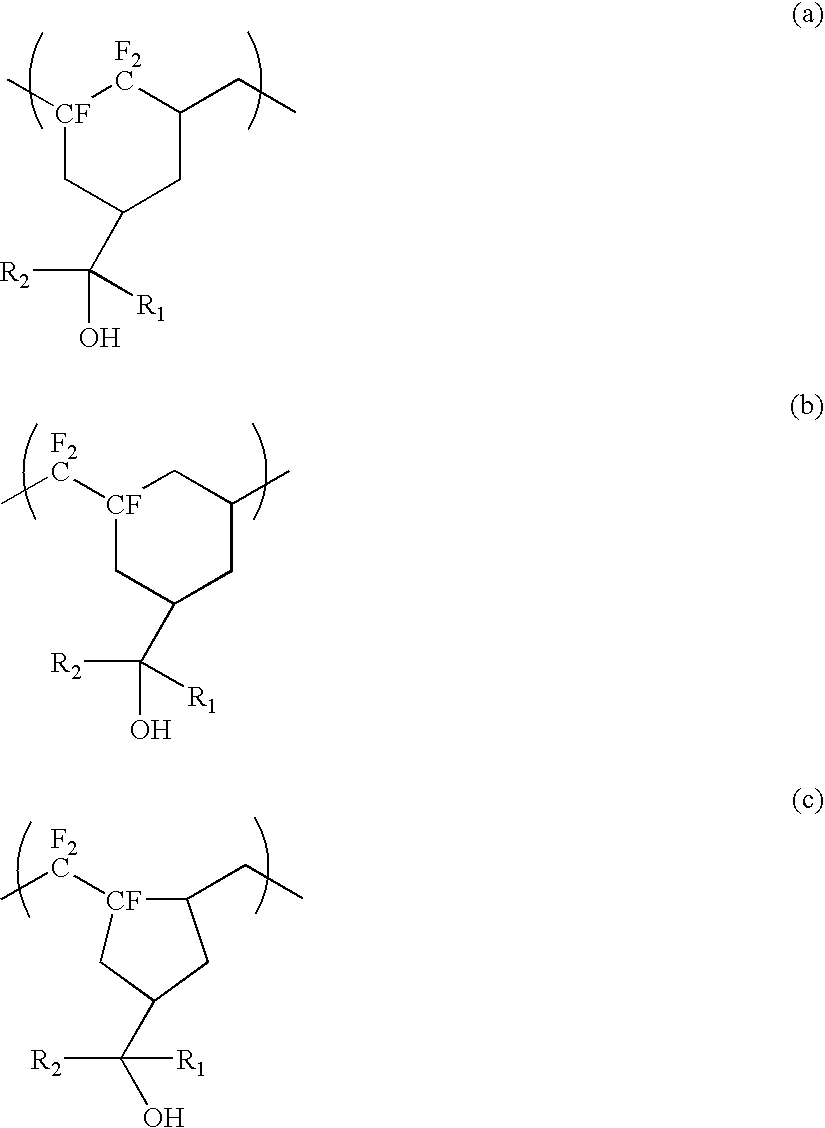Fluorinated compound, fluoropolymer and process for its production
a technology of fluorinated compounds and fluoropolymers, which is applied in the field of fluorinated compounds, fluoropolymers and processes for their production, can solve the problems of low concentration of functional groups, inability to obtain adequate properties of functional groups, and mechanical properties tend to decrease, so as to improve the solubility of aqueous alkali solutions, high chemical stability and heat resistance, and high acidity
- Summary
- Abstract
- Description
- Claims
- Application Information
AI Technical Summary
Benefits of technology
Problems solved by technology
Method used
Image
Examples
example 1
Preparation of CF2═CFCH2CH(C(CF3)2OH)CH2CH═CH2
[0051]Into a 1 L (liter) glass reactor, 500 g of CF2ClCFClI, 344 g of CH2═CHC(CF3)2OH and 32.6 g of BPO were put and heated to 95° C. for 71 hours. The reaction crude liquid was distilled under reduced pressure to obtain 544 g of CF2ClCFClCH2CHI(C(CF3)2OH) (55-58° C. / 0.2 kPa).
[0052]Into a 5 L glass reactor, 344 g of the above prepared CF2ClFClCH2CHI(C(CF3)2OH) and 1.7 L of dehydrated THF were put and cooled to −70° C. 1.8 L of a 2M-THF solution of CH2═CHCH2MgCl was dropwise added thereto over a period of 4 hours.
[0053]After the temperature was raised to 0° C. and stirring was carried out for 16 hours, 1.6 L of an aqueous saturated ammonium chloride solution was added thereto, and the temperature was raised to room temperature. The reaction solution was subjected to liquid separation, and the organic layer was concentrated by an evaporator and then distilled under reduced pressure to obtain 287 g of CF2ClCFClCH2CH(C(CF3)2OH)CH2CH═CH2 (62...
example 2
[0055]5 g of the monomer obtained in Example 1 was charged into a pressure resistant reactor made of glass and having an internal capacity of 30 mL. Then, 0.13 g of PFBPO was added as a polymerization initiator. The interior of the system was freeze-deaerated, and then the reactor was sealed, followed by polymerization for 19 hours in a constant temperature shaking bath (70° C.). After the polymerization, the reaction solution was diluted with R225 and was dropped into hexane to reprecipitate the polymer, followed by vacuum drying at 115° C. for 18 hours. As a result, 3.32 g of a non-crystalline polymer having fluorinated cyclic structures in its main chain (hereinafter referred to as the polymer 1A) was obtained. The molecular weight measured by GPC employing THF as a solvent and calculated as PSt, was such that the number average molecular weight (Mn) was 26,300, the weight average molecular weight (Mw) was 56,300, and Mw / Mn=2.14. Tg measured by the differential scanning calorimet...
example 3
[0058]4 g of the monomer obtained in Example 1 and 2.2 g of ethyl acetate were charged into a pressure resistant reactor made of glass and having an internal capacity of 30 mL. Then, 6.23 g of a 3 wt % solution of PFB in R225 was added as a polymerization initiator. The interior of the system was freeze-deaerated, and then the reactor was sealed, followed by polymerization for 41 hours in a constant temperature shaking bath (20° C.). After the polymerization, the reaction solution was dropped into hexane to reprecipitate the polymer, followed by vacuum drying at 90° C. for 21 hours. As a result, 1.33 g of a non-crystalline polymer having fluorinated cyclic structures in its main chain (hereinafter referred to as the polymer 2A), was obtained. The molecular weight measured by GPC employing THF as a solvent and calculated as PSt, was such that the number average molecular weight (Mn) was 15,600, and the weight average molecular weight (Mw) was 25,100, and Mw / Mn=1.61. Tg measured by th...
PUM
| Property | Measurement | Unit |
|---|---|---|
| mol % | aaaaa | aaaaa |
| pressure | aaaaa | aaaaa |
| pressure | aaaaa | aaaaa |
Abstract
Description
Claims
Application Information
 Login to View More
Login to View More - R&D
- Intellectual Property
- Life Sciences
- Materials
- Tech Scout
- Unparalleled Data Quality
- Higher Quality Content
- 60% Fewer Hallucinations
Browse by: Latest US Patents, China's latest patents, Technical Efficacy Thesaurus, Application Domain, Technology Topic, Popular Technical Reports.
© 2025 PatSnap. All rights reserved.Legal|Privacy policy|Modern Slavery Act Transparency Statement|Sitemap|About US| Contact US: help@patsnap.com



